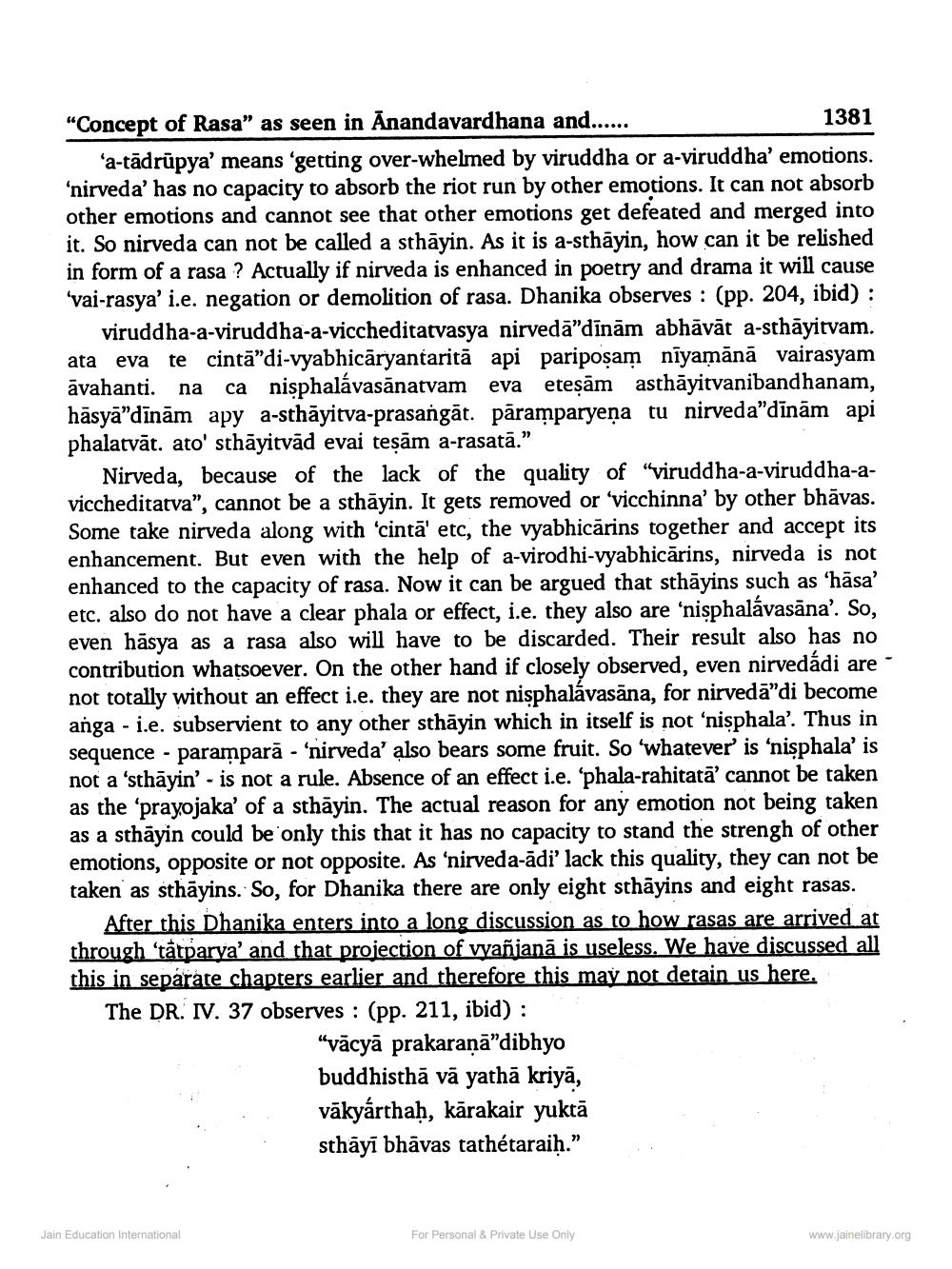________________
"Concept of Rasa” as seen in Anandavardhana and......
1381 ‘a-tādrūpya' means 'getting over-whelmed by viruddha or a-viruddha' emotions. 'nirveda' has no capacity to absorb the riot run by other emotions. It can not absorb other emotions and cannot see that other emotions get defeated and merged into it. So nirveda can not be called a sthāyin. As it is a-sthāyin, how can it be relished in form of a rasa ? Actually if nirveda is enhanced in poetry and drama it will cause 'vai-rasya' i.e. negation or demolition of rasa. Dhanika observes : (pp. 204, ibid) :
viruddha-a-viruddha-a-viccheditatvasya nirvedā"dīnām abhāvāt a-sthāyitvam. ata eva te cintā”di-vyabhicāryantaritā api pariposam niyamānā vairasyam āvahanti. na ca nisphalávasānarvam eva etesām asthāyitvanibandhanam, häsyā"dīnām apy a-sthāyitva-prasangāt. pāramparyena tu nirveda"dīnām api phalatvāt. ato' sthāyitvād evai tesām a-rasatā."
Nirveda, because of the lack of the quality of "viruddha-a-viruddha-aviccheditatva", cannot be a sthāyin. It gets removed or 'vicchinna' by other bhāvas. Some take nirveda along with 'cinta' etc, the vyabhicărins together and accept its enhancement. But even with the help of a-virodhi-vyabhicārins, nirveda is not enhanced to the capacity of rasa. Now it can be argued that sthāyins such etc. also do not have a clear phala or effect, i.e. they also are 'nisphalávasāna'. So, even hāsya as a rasa also will have to be discarded. Their result also has no contribution whatsoever. On the other hand if closely observed, even nirvedádi are not totally without an effect i.e. they are not nisphalávasāna, for nirvedā”di become anga - i.e. subservient to any other sthāyin which in itself is not 'nisphala'. Thus in sequence - paramparā - 'nirveda' also bears some fruit. So 'whatever is 'nisphala' is not a 'sthāyin' - is not a rule. Absence of an effect i.e. 'phala-rahitatā' cannot be taken as the 'prayojaka' of a sthāyin. The actual reason for any emotion not being taken as a sthāyin could be only this that it has no capacity to stand the strengh of other emotions, opposite or not opposite. As 'nirveda-ādi' lack this quality, they can not be taken as sthāyins. So, for Dhanika there are only eight sthāyins and eight rasas.
After this Dhanika enters into a long discussion as to how rasas are arrived at through 'tatparva' and that projection of wanjanā is useless. We have discussed all this in separate chapters earlier and therefore this may not detain us here. The DR. IV. 37 observes : (pp. 211, ibid) :
"vācyā prakaraņā”dibhyo buddhisthā vā yathā kriyā, vākyárthaḥ, kārakair yuktā sthāyī bhāvas tathétaraih.”
Jain Education International
For Personal & Private Use Only
www.jainelibrary.org




